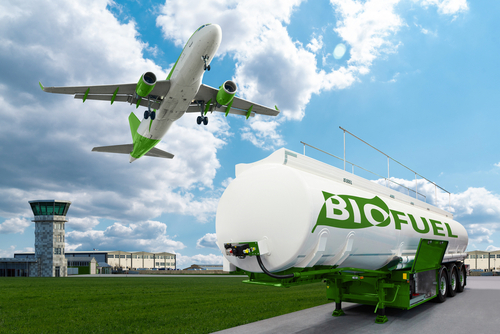
U.S. Secretary of Energy Jennifer Granholm recently released the U.S. Department of Energy’s plan to replace 100 percent of domestic aviation fuel with sustainable fuel by 2050.
The Sustainable Aviation Fuel Grand Challenge Roadmap outlines the government-wide strategy for scaling up technologies to produce sustainable aviation fuels (SAFs) across the U.S. airline industry. A collaboration between the U.S. Departments of Energy, Agriculture, and Transportation, as well as the Environmental Protection Agency and the Federal Aviation Administration, the roadmap will spur technological innovation to produce SAF while positioning the country to be a global leader in the SAF market.
“From field to flight, this data-driven technology strategy will help guide America’s scientists and industry to chart our course to clean skies,” Granholm said. “Not only is Sustainable Aviation Fuel critical to decarbonizing the airline industry and reaching our climate goals, but this plan will help American companies corner the market on a valuable emerging industry.”
Currently, U.S. commercial aviation consumes an estimated 10 percent of all transportation energy and contributes 2 percent of the nation’s CO2 emissions, the DOE said. Officials said SAF has the potential to deliver the performance of petroleum-based jet fuel with a fraction of its carbon footprint. SAF can be made with renewable biomass and other resources, like corn grains, algae, agricultural and forestry residues and municipal solid waste streams, officials said. Producing SAF can also create new economic opportunities, the department said, as well as boost aircraft performance.
“SAF development will be essential for airlines to further reduce their emissions, and A4A applauds today’s launch of the Biden Administration’s SAF Roadmap to support our shared goal of reaching net-zero emissions by 2050,” said Nicholas Calio, President and CEO of Airlines for America (A4A). “U.S. airlines have pledged to work with government and other stakeholders to make 3 billion gallons of cost-competitive SAF available to aircraft operators by 2030, and this roadmap outlines a variety of initiatives to help make that goal a reality,” he added.
The roadmap consists of two major goals: achieving a minimum of 50 percent reduction in greenhouse gas emissions compared to conventional fuel, and having a sufficient supply of SAF to meet 100 percent of aviation fuel needs by 2050. The SAF Grand Challenge includes expanding SAF supply and end use, reducing costs, and enhancing its sustainability, officials said.